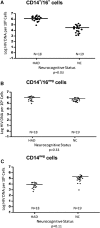HIV DNA in circulating monocytes as a mechanism to dementia and other HIV complications
- PMID: 20130221
- PMCID: PMC2858306
- DOI: 10.1189/jlb.0809571
HIV DNA in circulating monocytes as a mechanism to dementia and other HIV complications
Abstract
It is broadly accepted that HIV DNA in lymphoid and myeloid cells persists despite combination antiretroviral therapy. Recognized as the Achilles heel to HIV eradication, the role of these peripheral reservoirs in HIV morbidity is less well developed. The burden of HIV DNA in peripheral mononuclear cells is linked to HIV disease outcomes such as time to AIDS diagnosis, survival, and CD4 T-lymphocyte counts. Monocytes are a minor HIV DNA reservoir, and the burden of HIV DNA in these cells appears to be linked to dementia, suggesting that residual infection in this subset is linked to tissue-related HIV complications. Since monocytes are likely involved in trafficking virus to the brain, there is a strong mechanistic link underlying this discovery. Herein, we summarize our current understanding of monocyte HIV DNA and central nervous system dysfunction in humans. We present a model to understand these relationships and suggest possible treatment approaches to be tested.
Figures



Similar articles
-
Low blood CD8+ T-lymphocytes and high circulating monocytes are predictors of HIV-1-associated progressive encephalopathy in children.Pediatrics. 2003 Feb;111(2):E168-75. doi: 10.1542/peds.111.2.e168. Pediatrics. 2003. PMID: 12563091
-
Microbial translocation is associated with increased monocyte activation and dementia in AIDS patients.PLoS One. 2008 Jun 25;3(6):e2516. doi: 10.1371/journal.pone.0002516. PLoS One. 2008. PMID: 18575590 Free PMC article.
-
[Cellular HIV DNA quantitative testing and its significance in Chinese AIDS patients during 48 weeks' highly-active antiretroviral treatment].Zhonghua Nei Ke Za Zhi. 2012 Sep;51(9):708-12. Zhonghua Nei Ke Za Zhi. 2012. PMID: 23158922 Chinese.
-
Insights into the role of immune activation in HIV neuropathogenesis.J Neurovirol. 2002 Apr;8(2):69-75. doi: 10.1080/13550280290049525. J Neurovirol. 2002. PMID: 11935459 Review.
-
HIV-1-associated central nervous system dysfunction.Adv Pharmacol. 2000;49:315-85. doi: 10.1016/s1054-3589(00)49031-9. Adv Pharmacol. 2000. PMID: 11013768 Review.
Cited by
-
Cathepsin B and cystatin B in HIV-seropositive women are associated with infection and HIV-1-associated neurocognitive disorders.AIDS. 2013 Jan 28;27(3):347-56. doi: 10.1097/QAD.0b013e32835b3e47. AIDS. 2013. PMID: 23291538 Free PMC article.
-
HIV-1 Nef in macrophage-mediated disease pathogenesis.Int Rev Immunol. 2012 Dec;31(6):432-50. doi: 10.3109/08830185.2012.737073. Int Rev Immunol. 2012. PMID: 23215766 Free PMC article. Review.
-
Biotypes of Central Nervous System Complications in People With Human Immunodeficiency Virus: Virology, Immunology, and Neuropathology.J Infect Dis. 2023 Mar 17;227(Suppl 1):S3-S15. doi: 10.1093/infdis/jiac370. J Infect Dis. 2023. PMID: 36930640 Free PMC article.
-
Current Status of Latency Reversing Agents Facing the Heterogeneity of HIV-1 Cellular and Tissue Reservoirs.Front Microbiol. 2020 Jan 24;10:3060. doi: 10.3389/fmicb.2019.03060. eCollection 2019. Front Microbiol. 2020. PMID: 32038533 Free PMC article. Review.
-
Pathogenesis of HIV in the central nervous system.Curr HIV/AIDS Rep. 2011 Mar;8(1):54-61. doi: 10.1007/s11904-010-0070-4. Curr HIV/AIDS Rep. 2011. PMID: 21191673 Free PMC article. Review.
References
-
- McArthur J C, Sacktor N, Selnes O. Human immunodeficiency virus-associated dementia. Semin Neurol. 1999;19:129–150. - PubMed
-
- Sacktor N, McDermott M P, Marder K, Schifitto G, Selnes O A, McArthur J C, Stern Y, Albert S, Palumbo D, Kieburtz K, De Marcaida J A, Cohen B, Epstein L. HIV-associated cognitive impairment before and after the advent of combination therapy. J Neurovirol. 2002;8:136–142. - PubMed
-
- McArthur J C, Haughey N, Gartner S, Conant K, Pardo C, Nath A, Sacktor N. Human immunodeficiency virus-associated dementia: an evolving disease. J Neurovirol. 2003;9:205–221. - PubMed
-
- Robertson K R, Smurzynski M, Parsons T D, Wu K, Bosch R J, Wu J, McArthur J C, Collier A C, Evans S R, Ellis R J. The prevalence and incidence of neurocognitive impairment in the HAART era. AIDS. 2007;21:1915–1921. - PubMed
-
- Tozzi V, Balestra P, Lorenzini P. Prevalence and risk factors for human immunodeficiency virus-associated neurocognitive impairment, 1996 to 2002: results from an urban observational cohort. J Neurovirol. 2005;11:265–273. - PubMed
Publication types
MeSH terms
Substances
Grants and funding
- P20RR011091/RR/NCRR NIH HHS/United States
- R01 NS053345/NS/NINDS NIH HHS/United States
- U54 NS043049/NS/NINDS NIH HHS/United States
- U54NS43049/NS/NINDS NIH HHS/United States
- K23 AG032872/AG/NIA NIH HHS/United States
- U19 MH081835/MH/NIMH NIH HHS/United States
- U54 MD007584/MD/NIMHD NIH HHS/United States
- K23AG032872/AG/NIA NIH HHS/United States
- R21MH072388/MH/NIMH NIH HHS/United States
- R21 MH072388/MH/NIMH NIH HHS/United States
- U19MH081835/MH/NIMH NIH HHS/United States
- R01NS053345/NS/NINDS NIH HHS/United States
- P50 AG023501/AG/NIA NIH HHS/United States
- 3P50AG023501/AG/NIA NIH HHS/United States
- P20 RR011091/RR/NCRR NIH HHS/United States
- R01NS061696/NS/NINDS NIH HHS/United States
- R01 NS061696/NS/NINDS NIH HHS/United States
LinkOut - more resources
Full Text Sources
Medical
Research Materials

